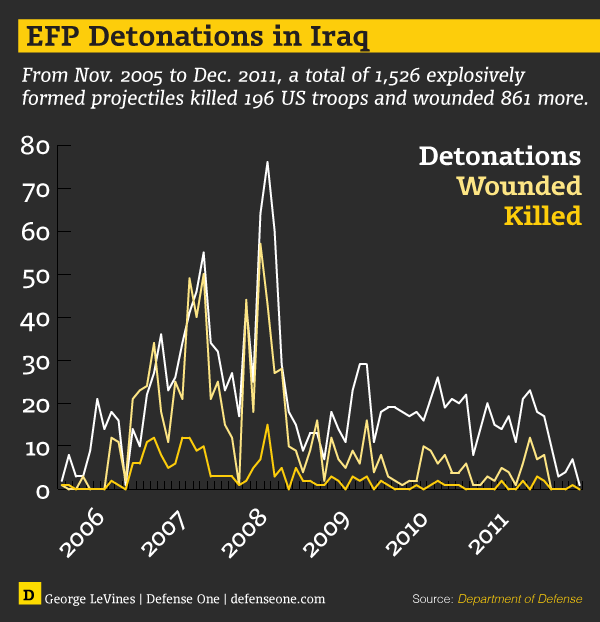
A humvee damaged by an EFP is looked over at the U.S. Army Patrol Base of the 2-28 Infantry in Al Hillah, 62 miles south of Baghdad. AP Photo/ David Rising
How Many US Troops Were Killed By Iranian IEDs in Iraq?
Far fewer than Congress thinks, according to newly declassified documents from U.S. Central Command.
Explosively formed penetrators — a particularly deadly form of roadside bomb — killed 196 American soldiers in Iraq over a five-and-a-half-year period, according to recently declassified Pentagon documents.
That’s about half as many deaths as lawmakers have attributed to the bombs, which U.S. officials say were largely supplied by Iran’s elite Quds Force.
The carnage wrought by EFPs returned to the news over the summer, as opponents of the nuclear deal with Iran cited Tehran’s behind-the-scenes actions against U.S. troops during Operation Iraqi Freedom as a reason to scuttle the agreement. Sen. Ted Cruz, a Texas Republican who is also running for president, and others in Congress have said that EFPs had killed more than 500 troops.
“I understand that the Joint Personnel Recovery Agency has a classified list of roughly 500 American soldiers who were murdered by Iranian IEDs,” Cruz said at a July 29 Senate Armed Services Committee hearing.
But data from U.S. Central Command, which runs U.S. military operations in the Middle East, suggests the actual toll is far less. According to the first comprehensive accounting, between November 2005 and December 2011, 1,526 EFPs killed a total of 196 U.S. troops and injured 861.

Between October 2006 and September 2007, EFPs killed 97 U.S. troops and wounded more than 300 soldiers. EFP attacks peaked in March, April and May 2008, near the end of the American troop surge, when 200 of the bombs were detonated. The deadliest month was April 2008, when EFPs killed 15 U.S. soldiers.
The Pentagon attributes the presence of EFPs in Iraq to the Quds Force, the special forces arm of the Iranian Revolutionary Guard led by Qasem Soleimani. Various EFP “factories” were found throughout Iraq during Operation Iraqi Freedom. Still, the exact degree to which Iran bears culpability for arming Shia militias in Iraq with EFPs and related equipment is a matter of some dispute.
“We weren’t always able to attribute the casualties that we had to Iranian activity, although many times we suspected it was Iranian activity, even though we didn't necessarily have the forensics to support that,” Gen. Joseph Dunford, the incoming chairman of the Joint Chiefs of Staff, said at his July 9 confirmation hearing. During the hearing, Dunford said the numbers of American soldiers killed by Iran “has been recently quoted as about 500.”
CENTCOM later clarified that Dunford was referring to total American deaths by EFPs and other Iranian weapons. It is “important to understand that the CENTCOM statistics on EFP detonations are a subset of all the Iranian activities estimated to have killed approximately 500 U.S. troops in Iraq during OIF,” Maj. Genieve David, a CENTCOM spokeswoman, said in an email. Data about the roughly 300 deaths not caused by EFPs, including the kind of weapons used in the attacks, is classified, David said.
A few weeks later, at the July 29 hearing, Gen. Martin Dempsey, the outgoing Joint Chiefs chairman, said “several hundred” American forces were killed by EFPs.
Phil Novack, a spokesman for Cruz, told Defense One that the Senator's office is working with the Pentagon to get specific numbers. He said Cruz used the 500 number based on Dunford's testimony.
Cruz “asked Secretary Carter to inform the families of the 500 service members who were killed by Iranian EFPs that their loved ones were murdered by the same man who will now receive sanctions relief,” Novack said in an email. “Whether the number is 500 lives or 196 is immaterial; the fact remains that General Soleimani — a man responsible for the deaths of hundreds of American service members — will receive sanctions relief to the tune of millions of dollars if this deal is approved."
The arrival of EFPs on the Iraqi battlefield around 2005 came as a shock to U.S. planners. Along with more run-of-the-mill improvised explosive devices, the deadly bombs drove a crash effort to create and deploy vehicles with far better armor.
Whereas most roadside bombs send energy and shrapnel in all directions, EFPs work more like cannons. The force of the blast molds a concave metal disc, called a liner, into a “formed penetrator” which is propelled at up to 3,000 meters per second. The effect is incredibly destructive, even to up-armored Humvees.
“You can do as much or more damage with a 5-pound EFP, which is aimed, as with a 200-pound conventional IED,” a Pentagon analyst told Los Angeles Times writer Andrew Cockburn in 2007. The analyst speculated that the cost to construct such a device was about $30 or less. They’ve been around since at least World War II, when resistance elements in Europe used them against Germans, Cockburn wrote.
Among the other Iranian arms introduced to the Iraqi battlefield is the improvised rocket assisted munition, described in one Joint IED Defeat Organization document as “a rocket-fired improvised explosive device made from a large metal canister — such as a propane gas tank — filled with explosives, scrap metal and ball bearings and propelled by rockets.”
First seen in Iraq in 2007, the IRAM — “essentially an airborne version of a roadside bomb — a flying IED” is ”the signature weapon used by Iranian-backed militias that operate with the aid of Iran’s Islamic Revolutionary Guards Group,” the undated document says.
Patrick Tucker and Molly O’Toole contributed to this report.




